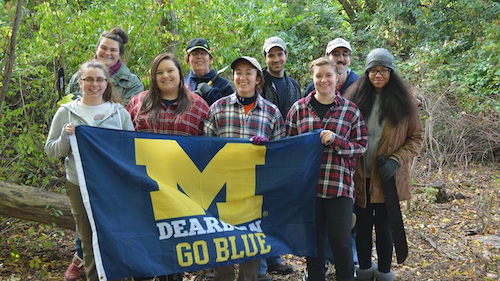
Walking up a hill, John Chenoweth stopped in a wooded area. Looking around, he and his students saw overgrown brush and litter. The assistant professor of anthropology told his class they were standing on the site of a mid-19th century church with a spire so tall it was rumored to have been seen from miles away.
As the ANTH 410: Archaeology Field School class started to clear the area, they saw foundation stones and scattered bricks mashed into the earth. It’s what was left of the First Free Church, built in 1855.
“I wonder how many people have walked right by it. I probably would have,” said Laura Bossio, an anthropology senior. “Among many other things, this class has shown me how important it is to really look. There is so much you can miss if you don’t.”
When the church was built, it was the only communal meeting area for residents for miles around, showing the church’s significance to the mid-1800s settlement in present day Superior Township, Mich. But as important as it was, information has disappeared over time. Church records were lost. Closed in 1934, there is only one known photograph. Locals know it was there, but little else.
Chenoweth—who lives in the area and learned about the site from Superior Township historian Karl Williams—offered for his students to be the first to excavate the site.
“I’m a believer that you aren’t taught something, you learn it. And the best way to do that is through experience,” Chenoweth said. “Not all of my students are going to become archeologists, but I want them to realize that science is a messy process no matter which science you go into. Things get complicated and change day to day, moment by moment. You might have to reinterpret how you understand something, which may affect your research questions. Whether it’s researching a 150-year-old church or the cure for cancer, it’s exercising the same muscles.”
Students are looking at the church and the congregation as a social entity, and are asking questions like: “How was this religious community formed and maintained?” and “Who attended and why?”
After clearing and mapping the area, students conducted excavations nearly every Friday this fall. At the end of the semester, they were in the Archeology Lab examining their finds.
“Any bit of information is helpful,” Chenoweth said. “Things that might seem like minutia, like pieces of glass or the type of nails used, can tell us about a community when put in historical context.”
Chenoweth will lead future field schools in this same area. He expects the project to take several years and include researching (but not excavating) the cemetery adjacent to the Free Church site and the remains of a former structure near the bottom of the hill. He will share findings with the Superior Township Board and students will present papers at the 2016 Midwest Archeological Conference, which UM-Dearborn is co-hosting along with Wayne State and U-M Ann Arbor.
Bossio also is doing a GIS independent study and plans to map the location both with what is there today and what was there historically. She said the course was different than any other college experience she’s had.
“I’ve learned more in this class because it is so hands-on. We are the ones who cleared the area and gathered artifacts to help find out more about the people at the Free Church,” she said. “Not only is the work we are doing in this class interesting, it has significance that goes beyond us.”





